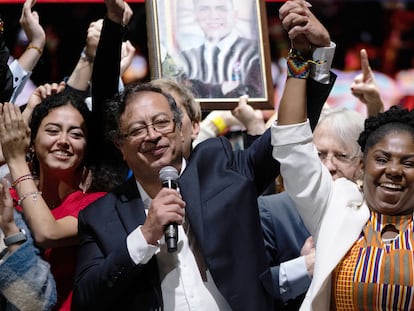How Colombia shifted to the left
Gustavo Petro won the presidential election by increasing turnout throughout the country, especially in areas that already supported him
The results of the Colombian presidential election quickly indicated an important shift. Less than hour after the polls closed on Sunday, the country had a clear idea of its political future. This future reflected a new image for Colombia: for the first time since its independence in 1810, Colombia had voted for a leftist president. Ex-guerrilla Gustavo Petro won more than 50% of the vote – 11 million votes in total – to resoundingly win the runoff against Rodolfo Hernández. His Pacto Histórico coalition saw a smaller rise in support than Hernández, who nearly doubled his first-round vote, but it was more than enough to give him a clear win.
This victory does not come from a void, it is the product of an evolution that began years ago. There are two ways to look at it. One is ideological. The left, led by Petro, went from 0% in 2010 to 41.7% in 2018 and from 41.7% to 50.5% in 2022 – a major rise in just 12 years.
The other way to look at Petro’s victory is by focusing on the discontent with the political establishment. The mathematician Antanas Mockus was the first “alternative” in the last decade who managed to make it to a runoff vote. Today, if we count Rodolfo Hernández as an anti-establishment candidate (given he beat the traditional right-wing candidate in the first round), the 2022 runoff was between two populist proposals. But it was Petro who won the battle to be the flag-bearer of change (first between the center and the left, then between the right, the center and the left).
And Petro won this battle by increasing voter turnout. In the leadup to the runoff, Hernández dipped in the polls, leading many to wonder if a section of undecided voters could sway the vote against Petro. In other words, it was believed that it would be easier for Petro to win if fewer, not more voters turned out on election day. But 2.7 million more people voted for him and voter turnout was higher in the runoff than for the first round.
The only possible conclusion from these data is that Petro’s proposal, with its both leftist and anti-establishment message, was able to mobilize voters in a way that few believed possible. His victory does not come down to luck, nor can it (solely) be explained by Hernández’s failure to win over support (although this probably helped him win). His victory is based on the fact that voter turnout rose in every department of Colombia. This was seen even in the areas that were most opposed to him (although to a lesser extent) and in which, as expected, he did not win: Hernández’s native Santander and Álvaro Uribe’s Antioquia.
The election map continues to show the divides in Colombia, which is split between the traditionally conservative inland areas and the more liberal and now leftist coast. But Petro was able to sway voters even in the areas that were (and are) opposed to him.
Even more importantly, this spike in support even took place in areas where the aggregate voter turnout didn’t rise. While in coastal areas – where Petro needed to win more votes – turnout soared. The data indicate that he succeeded in winning this support.
In the Pacific region, voter turnout in the first round was already much higher than it was in 2018, likely thanks to Petro’s running mate Francia Márquez, a Black environmental activist, who was able to win over support in the Afro-Colombian area. There were concerns she would have less of an impact in the runoff, given that Hernández’s running mate, Marelen Castillo, was also a woman of Afro-Colombian descent.
However, that does not seem to have happened. In the poorest areas of the country, which have the greatest logistical difficulties in reaching the polls, there was record-high turnout. It remains to be seen whether this historical milestone will be repeated in future elections.
In the Caribbean region, on the other hand, the first-round turnout was lower than expected, but rose for the runoff vote. It will be necessary to analyze what was it that prompted voters to vote on Sunday, but not in the first round on May 29.
The data underscore that Petro became Colombia’s first leftist president by mobilizing voters. In other words, he had to raise the bar. And this would not have been possible if it were not for the fact that the average voter sits somewhere between the center and the left on all political issues.
Colombia is becoming a less conservative country than many (especially Colombian conservatives themselves) appear to believe. And the results of the 2022 presidential elections only confirm this.
Tu suscripción se está usando en otro dispositivo
¿Quieres añadir otro usuario a tu suscripción?
Si continúas leyendo en este dispositivo, no se podrá leer en el otro.
FlechaTu suscripción se está usando en otro dispositivo y solo puedes acceder a EL PAÍS desde un dispositivo a la vez.
Si quieres compartir tu cuenta, cambia tu suscripción a la modalidad Premium, así podrás añadir otro usuario. Cada uno accederá con su propia cuenta de email, lo que os permitirá personalizar vuestra experiencia en EL PAÍS.
¿Tienes una suscripción de empresa? Accede aquí para contratar más cuentas.
En el caso de no saber quién está usando tu cuenta, te recomendamos cambiar tu contraseña aquí.
Si decides continuar compartiendo tu cuenta, este mensaje se mostrará en tu dispositivo y en el de la otra persona que está usando tu cuenta de forma indefinida, afectando a tu experiencia de lectura. Puedes consultar aquí los términos y condiciones de la suscripción digital.
More information
Últimas noticias
Maduro pleads not guilty before the federal court in New York: ‘I am still the president of Venezuela’
A new test can detect Alzheimer’s from a finger prick
UN team enters Sudanese city of El Fasher after paramilitary massacre: ‘It’s like a ghost town’
A recipe for resistance: Indigenous peoples politicize their struggles from the kitchen
Most viewed
- Gilles Lipovetsky: ‘If you want to live better and fall in love, take Prozac, don’t look to philosophy’
- Alain Aspect, Nobel laureate in physics: ‘Einstein was so smart that he would have had to recognize quantum entanglement’
- Maduro’s downfall puts China’s relationship with Venezuela to the test
- Why oil has been at the center of Venezuela-US conflicts for decades
- Alvin Hellerstein, a 92-year-old judge appointed by Bill Clinton, to preside over Maduro’s trial in New York











































